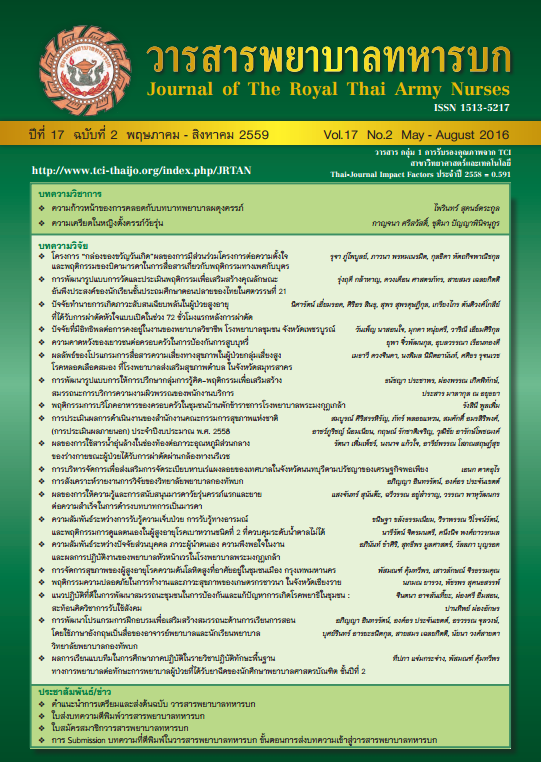ผลลัพธ์ของโปรแกรมการสื่อสารความเสี่ยงทางสุขภาพ ในผู้ป่วยกลุ่มเสี่ยงสูง โรคหลอดเลือดสมอง
Keywords:
การสื่อสารความเสี่ยงทางสุขภาพ, ผู้ป่วยกลุ่มเสี่ยงสูง, โรคหลอดเลือดสมอง, Health risk communication, High risk patients, StrokeAbstract
การวิจัยนี้เป็นการวิจัยกึ่งทดลองแบบกลุ่มเดียวเปรียบเทียบก่อน - หลัง มีวัตถุประสงค์เพื่อศึกษาผลลัพธ์ของโปรแกรมการสื่อสารความเสี่ยงทางสุขภาพ ในผู้ป่วยกลุ่มเสี่ยงสูง โรคหลอดเลือดสมองที่มารับบริการ ณ โรงพยาบาลส่งเสริมสุขภาพตำบลในอำเภอกระทุ่มแบน จังหวัดสมุทรสาคร กลุ่มตัวอย่างเป็นผู้ป่วยที่มีความเสี่ยงสูง โรคหลอดเลือดสมองจำนวน 38 ราย ใช้การเก็บข้อมูลทั้งเชิงปริมาณและเชิงคุณภาพ ในระหว่างเดือนพฤศจิกายนถึงธันวาคม พ.ศ. 2557 เครื่องมือที่ใช้ในการเก็บรวบรวมข้อมูลประกอบด้วย แบบสังเกตกระบวนการกลุ่ม แบบสัมภาษณ์การติดต่อเยี่ยมทางโทรศัพท์ แบบวัดความรู้และแบบสอบถามพฤติกรรมการป้องกันโรค ตรวจสอบคุณภาพเครื่องมือโดยผู้ทรงคุณวุฒิ 5 ท่าน โดยมีค่าความเชื่อมั่นของแบบวัดความรู้และแบบสอบถามพฤติกรรมการป้องกันโรค เท่ากับ .88 และ .76 ตามลำดับ วิเคราะห์ข้อมูลเชิงคุณภาพด้วยวิธีวิเคราะห์เชิงเนื้อหา ส่วนข้อมูลเชิงปริมาณใช้สถิติเชิงพรรณนาและสถิติทีผลการวิจัย พบว่า กลุ่มตัวอย่างส่วนใหญ่เป็นเพศหญิง อายุระหว่าง 51 - 60 ปี อาชีพเกษตรกรรม และป่วยด้วยโรคเรื้อรังได้แก่ ความดันโลหิตสูง เบาหวานและไขมันในเลือดสูง ส่วนใหญ่ไม่เคยได้รับความรู้เกี่ยวกับโรคหลอดเลือดสมองมาก่อน ไม่ทราบว่าตนเป็นผู้มีความเสี่ยงสูง จึงรู้สึกตกใจและเกิดความกลัวต่อความตาย ความพิการและการเป็นภาระของครอบครัว ต้องการได้รับข้อมูลสุขภาพจากทีมสุขภาพและแผ่นป้ายความรู้ขนาดใหญ่ กระบวนการเรียนรู้แบบกลุ่มทำให้กลุ่มตัวอย่างมีโอกาสแสดงความคิดเห็นตามการรับรู้และประสบการณ์ของแต่ละคนอย่างทั่วถึง ทำให้เกิดการเรียนรู้ที่ดี การติดตามเยี่ยมทางโทรศัพท์มีประโยชน์ในการกำกับติดตามและประเมินความเสี่ยง อนึ่ง ภายหลังเข้าร่วมโปรแกรมฯ กลุ่มตัวอย่างมีค่าคะแนนเฉลี่ยความรู้และพฤติกรรมการป้องกันโรคหลอดเลือดสมองสูงกว่าก่อนการเข้าร่วมโปรแกรมฯ อย่างมีนัยสำคัญทางสถิติที่ p - value < .05 ผู้วิจัยเสนอแนะว่า โปรแกรมการสื่อสารความเสี่ยงทางสุขภาพโดยการจัดการเรียนรู้แบบกลุ่ม การติดต่อเยี่ยมทางโทรศัพท์และการใช้สื่อสุขภาพที่เหมาะสม เป็นวิธีการสื่อสารที่มีประสิทธิภาพในการลดความเสี่ยงต่อการเกิดโรคหลอดเลือดสมอง ดังนั้นพยาบาลเวชปฏิบัติชุมชนและบุคลากรทางสุขภาพควรนำโปรแกรมฯ นี้ ไปประยุกต์กับผู้ป่วยกลุ่มเสี่ยงสูงในชุมชน เพื่อช่วยลดอุบัติการณ์การเกิดโรคหลอดเลือดสมองในผู้ป่วยกลุ่มนี้
The Outcomes of Health Risk Communication Program Amongst High Risk Stroke Patients at Sub - district Health Promoting Hospitals in SamutSakhon Province
The purpose of this quasi - experimental research one group pretest-posttest design was to study the outcomes of health risk communication program amongst high risk stroke patients at Sub - district Health Promoting Hospitals in Samut Sakhon province. The sample consisted of 38 participants. Data were collected from November to December, 2014, quantitative and qualitative methods were used. The health risk communication program included a group learning management and a set of telephone interview guidelines. The research instruments were consisted of the measurement of disease knowledge and a set of preventive behavior questionnaires which verified for content validity by a panel of five experts. The reliability was presented at .88 and .76 respectively. The quantitative data were analyzed by using descriptive statistics and paired - t test, while using content analysis for qualitative data. The research’s finding revealed that the majority was female, worked as farmers, aged group from 51 to 60 years old. Most of them were diagnosed Hypertension, Diabetes Mellitus, and Dyslipidemia. They did not receive any prior health knowledge and they did not know were at high risk group of stroke. Moreover, they felt frightened, worried to die or disabled, and led the family’s burden. They needed health information from health care providers and the bigger posters. The group learning process provided the opportunity for sharing experiences and a better learning. The telephone visit was useful for monitoring and risk assessment. After
receiving the program, the sample were statistically significant with a higher mean scores of knowledge and preventive behaviors (p - value < .05). The researcher recommends that group learning process, telephone visit, and appropriate health medias are the effective communication for reducing stroke. The community nurse practitioners and health care personnel should apply health risk communication program for high risk stroke patients in the community. This will minimize the incidence of stroke for high risk stroke patients.
Downloads
Downloads
How to Cite
Issue
Section
License
บทความหรือข้อคิดเห็นใดใดที่ปรากฏในวารสารพยาบาลทหารบกเป็นวรรณกรรมของผู้เขียน ซึ่งบรรณาธิการหรือสมาคมพยาบาลทหารบก ไม่จำเป็นต้องเห็นด้วย
บทความที่ได้รับการตีพิมพ์เป็นลิขสิทธิ์ของวารสารพยาบาลทหารบก
The ideas and opinions expressed in the Journal of The Royal Thai Army Nurses are those of the authors and not necessarily those
of the editor or Royal Thai Army Nurses Association.






